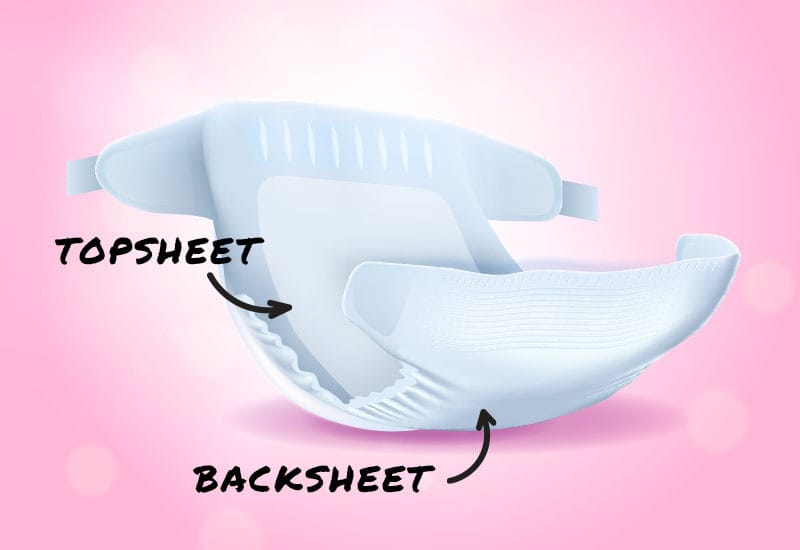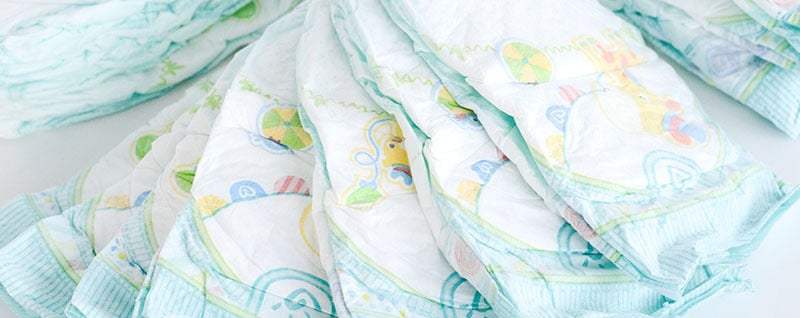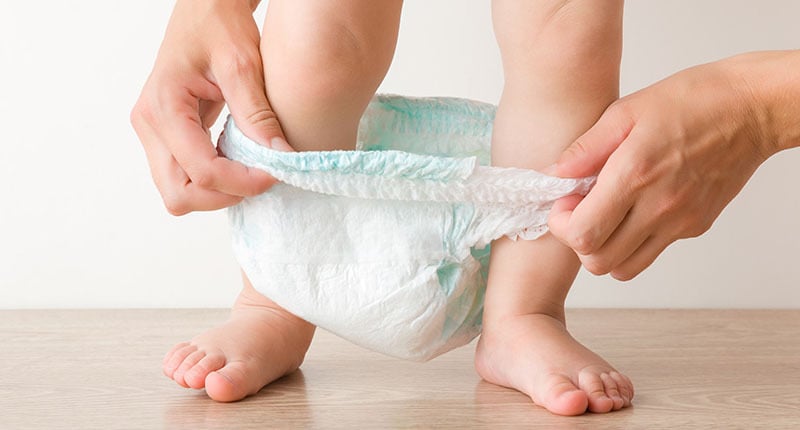THURSDAY, DECEMBER 10, 2020
Babies and young children typically spend the majority of their first years in diapers. But many disposable diapers contain hazardous chemicals that can harm their health. Scientific assessments of disposable diapers have detected pesticides and chemicals linked to cancer, impaired reproductive development and dermatitis, among other harms.1
Babies are particularly susceptible to the risks associated with exposure to harmful chemicals. But the Consumer Product Safety Commission – the agency that regulates the diaper industry – does not require diaper manufacturers to test their products or materials for a variety of chemicals to ensure safety. It also does not require manufacturers to disclose their products’ ingredients, making it increasingly difficult for consumers to find safer options. The agency requires that baby diapers be tested for lead.

EWG developed our comprehensive Guide to Safer Diapers to help parents and caregivers sort through the vast array of product options – and related advertising claims – available on the market. Our guide details the health and environmental hazards associated with the ingredients and materials used in the manufacturing of diapers, makes recommendations for safer options, and provides the information all caregivers need to know before buying another diaper.
Interested in the digested version of this guide? EWG has also developed a list of quick tips for choosing safer diapers.
The specific ingredients or materials used in diapers can vary by brand. Below are the ones most commonly used across the diaper industry.
Plastic components
Disposable diapers have five main components – the topsheet, backsheet, core, leg cuffs and closing system. The topsheet (the inside layer of the diaper that is flush with the baby’s skin) and the backsheet (the layer facing the baby’s clothes or surrounding environment) are made primarily of plastic polymers like polypropylene and polyethylene. Plastic polymers are also used in the leg cuffs and closing system.

Phthalates, a class of plasticizer chemicals, are commonly added to plastic polymers to increase the flexibility of the plastic. Several studies have detected phthalates in diapers.2
According to the Centers for Disease Control and Prevention’s Fourth National Report on Human Exposure to Environmental Chemicals, phthalates are commonly detected in the bodies of Americans, including in children.3 Since they are weakly bound to the materials to which they are added, they are easily released. According to the National Institutes of Environmental Health Sciences, phthalates are known endocrine disruptors, potentially affecting the normal functioning of the hormone system.4 Scientific studies have linked certain phthalates to reproductive abnormalities, such as hypospadias (a male birth defect) and low sperm count.
An article in the journal Environmental Science and Technology assessed the toxicity of a range of products made from eight plastic chemicals commonly found in consumer goods, including disposable diapers. The researchers found that roughly two-thirds of the plastic products assessed triggered a negative endpoint, such as induced estrogenicity, anti-androgenicity and oxidative stress responses in the in vitro assays.5
Plastic components may also emit, or off-gas, volatile organic chemicals, known as VOCs. These are organic compounds that easily become vapors or gases, many of which are hazardous air pollutants. Many components used in the manufacturing of disposable diapers, including plastics and adhesives, can emit VOCs, posing a risk for inhalation and absorption through the skin.
A study in the journal Reproductive Toxicology tested four different brands of diapers and detected the VOCs toluene and xylene in all of them. Both chemicals may be inhaled or absorbed through the skin and are known reproductive toxicants. The study authors note that “the physical location of the exposure site, the high absorption rate of the genitalia for chemicals, and the long-term exposure period” are all cause for concern.6
Short-term exposure to moderate to high levels of VOCs can lead to eye, nose and throat irritation, headaches, nausea and loss of coordination.7 Long-term exposure to some of these chemicals have been linked to kidney, liver and nervous system damage. Some VOCs, like formaldehyde, are known carcinogens.8
Despite advancements in the manufacturing of disposable diapers, plastic components remain an important element for optimal performance. Until the market is able to transition away from plastic fully, EWG recommends choosing products from companies that minimize the total amount of plastic materials used and ensure that their products do not contain phthalates or emit harmful levels of VOCs.
Super-absorbent polymers or gelling agents
Disposable diapers typically include a super-absorbent polymer, or SAP, in their core. SAPs are drying agents that can absorb 30 times their own weight in liquid.9
Sodium polyacrylate is one of the most common SAPs used in diapers. Depending on how this polymer is manufactured, it may be contaminated with residual amounts of acrylamide and acrylic acid.10 The National Toxicology Program has classified acrylamide as reasonably anticipated to cause cancer in humans, based on studies assessing oral ingestion.11 Additionally, the Environmental Protection Agency has found that acrylic acid is a strong skin and eye irritant.12
Some manufacturers include other additives in their SAP, but with the lack of disclosure in the diaper industry, those chemicals are often unknown.

EWG recommends consumers choose products from companies that have adequately tested their products for contaminants like acrylic acid and acrylamide to ensure the levels are below applicable safety thresholds. It is also important to look for brands that completely disclose the ingredients and materials used in their products.
Bleaching agents
Along with super-absorbent polymers, manufacturers often include pulp in the core of disposable diapers to increase absorbency. Prior to the 1990s, this pulp was purified through a bleaching process using elemental chlorine to make the fibers absorbent, soft and white. That process produced potent carcinogenic impurities known as dioxins and has since been largely phased out.
Today, the more common whitening processes use elemental chlorine-free, or ECF, and total chlorine-free, or TCF, techniques. According to a report on trends in chemical pulp production, of the pulp bleached in 2006, 88 percent was ECF-bleached, 5 percent was TCF-bleached, and 6 percent was bleached with elemental chlorine.13 ECF uses a chlorine derivative as the bleaching agent, whereas TCF bleaching uses no chlorine-derived chemicals, instead relying on hydrogen peroxide, oxygen or ozone.
Both ECF and TCF bleaching techniques are safer alternatives to chlorine bleaching. However, the ECF process relies on the use of chlorine derivatives, such as chlorine dioxide, which can cause skin, nose and throat irritation and is toxic to aquatic systems. According to the Agency for Toxic Substances and Disease Registry, exposure to chlorine dioxide in children may reduce the capacity of blood to carry oxygen, making it difficult to breathe.14

Additionally, according to the California Department of Resources Recycling and Recovery, TCF is better for the environment than ECF. The chlorine derivatives used in ECF can produce toxic chlorinated organic compounds, such as chloroform, which are then released into the waterways, where they cause environmental and aquatic damage.15
Although bleaching is used to get the desired whiteness most consumers are used to, it is not completely necessary. Some brands now use pulp that is completely unbleached instead of bleached.
EWG recommends that consumers choose disposable diapers with unbleached pulp or those that use TCF bleaching agents only. For reusable diapers, we recommend a product that uses unbleached, organic cotton.
Adhesives
Most disposable diapers are assembled using adhesives. The backsheet, absorbent core and topsheet components are made by gluing several layers together. Depending on the specific glues used, they may be one of the main sources of VOCs in diapers.
Many adhesives include alkylphenol ethoxylates, or APEOs, and alkylphenol derivatives. These antioxidant chemicals are added to glues to prevent oxidation, which degrades the glue’s adhesive properties.
According to the EPA, some APEOs are highly toxic to aquatic life and have been associated with reproductive and developmental problems in rodents.16 Some alkylphenols are known endocrine disruptors, which can interfere with the endocrine and reproductive systems. A study in the journal Science of the Total Environment shows that APEO metabolites can mimic the hormone estrogen.17 A recent study in the journal Environmental Pollution found that higher exposure to these endocrine-disrupting alkylphenols is associated with endometrial cancer.18
Colophony, a sticky resin from pine trees, and formaldehyde-resin glues are used in some disposable diapers. According to a study in the journal Minnesota Medicine, colophony can cause contact dermatitis, an allergy that can causes skin redness, swelling and itching.19 Formaldehyde-resin glues emit formaldehyde, a known human carcinogen, into the air.
Although glues are still heavily used in the disposable diaper industry, new technologies are being developed to assemble products without them. For example, heat and ultrasonic techniques are being used and would minimize, if not all together eliminate, the use of glues.20

Wetness indicators
Some diaper companies include wetness indicators in the product to help alert parents and caregivers that a baby needs a diaper change. Although convenient, this extra feature may not be worth the added risk.
Most wetness indicators include dye or a pH indicator within a carrier matrix. When urine contacts the dye or pH strip, the color is either intensified or altered, indicating that it is time for a diaper change. Although the exact composition may vary, many of the carrier matrixes used in wetness indicators are composed of harmful chemicals, including quaternary ammonium compounds, or quats, and halogenated organic compounds.
Quats have been associated with several health concerns, including reproductive and developmental problems, dermal irritation and respiratory effects, including asthma. Halogenated organic compounds are persistent and pose a risk to environmental health.
Carrier matrixes can also include petroleum-derived and ethoxylated compounds, both of which are often contaminated with harmful impurities. The potentially carcinogenic chemical 1,4-dioxane is formed during the process of ethoxylation and can contaminate ethoxylated ingredients. And petroleum-derived components are often contaminated with polycyclic aromatic hydrocarbons, or PAHs, which have been linked to reproductive issues, birth defects and lower body weights in mice. Additionally, the Department of Health and Human Services indicates that some PAHs may reasonably be carcinogens.21
Diapers without wetness indicators may be the best bet. However, for parents who rely on the convenience of these indicators, EWG recommends choosing products from manufacturers that do not use indicators made with quats, halogenated organic compounds or other hazardous chemicals.
Fragrance and perfume
According to a study in the Journal of Environmental Health, more than 30 percent of the U.S. population reported experiencing irritation from fragrance added to an array of consumer products.22 Contact dermatitis, which can be triggered by fragrances, affects about one in five children.23 Additionally, the National Eczema Association says 1 to 4 percent of the general population has a fragrance sensitivity.24 Fragrance chemicals can trigger allergic reactions such as asthma attacks, headaches, contact dermatitis and respiratory difficulties.
Many companies claim their fragrance mixture is proprietary and use the umbrella term “fragrance” rather than disclose the specific ingredients. This term can hide any number of up to 4,000 different chemicals.
According to an article in the journal Environmental Health Perspectives, “a single fragrance in a product can contain a mixture of hundreds of chemicals, some of which (e.g., limonene, a citrus scent) react with ozone in ambient air to form dangerous secondary pollutants, including formaldehyde.”25 Fragrances can also contain phthalates and synthetic musks, which are classes of endocrine-disrupting chemicals; essential oils, some of which are potent sensitizing chemicals; and a number of other ingredients that haven’t been adequately assessed for safety.
Since children are more sensitive to chemical exposure than adults, it is best to reduce their exposure to fragrance ingredients by choosing fragrance-free diapers. Be wary of products marketed “unscented” and always check the ingredients, since the manufacturer may have added fragrances to mask the smell. If you prefer diapers with fragrance, choose products that disclose the exact ingredients that are used.
Cotton and other natural fibers
Cotton and other natural fibers are commonly used in disposable and reusable diapers. According to the Organic Trade Association, cotton is the third-most-pesticide-treated crop in the U.S.26 Many of the pesticides used on cotton have been linked to cancer and endocrine disruption. A 2019 study by the French Agency for Food, Environmental and Occupational Health and Safety detected three pesticides, including glyphosate, and two corresponding metabolites in the diapers it tested.27 The International Agency for Research on Cancer classifies glyphosate as “probably carcinogenic to humans,” and California’s Proposition 65 registry lists it as a known carcinogen.28,29

Most manufacturers of disposable diapers do not use organic cotton. However, some make sure to use natural fibers that do not contain detectable levels of harmful pesticides. If you are concerned about pesticides in your baby’s diapers, check with the manufacturer to see whether it has tested the products or has a sourcing policy that addresses pesticide residues. Reusable organic cotton diapers may also be an option.
Colorants
Colors and patterns on diapers may be aesthetically pleasing, but they are not always without concern. Many dyes and inks can cause allergic reactions and can be contaminated with heavy metals, like lead. The authors of a study in Pediatrics, the official journal of the American Academy of Pediatrics, suggests that dyes in baby diapers were responsible for cases of allergic contact dermatitis recorded in their study.30
If possible, choose plain products with minimal or no colorants. If they are used, make sure the manufacturer has chosen the safest ones available.
Other Factors To Consider
Environmental impacts
Disposable diapers are made largely of plastic materials that do not readily degrade in the environment. According to the EPA, an estimated 4.2 million tons of disposable diaper waste were generated in 2017. Disposable diapers accounted for over 12 percent of all nondurable goods in landfills, amounting to more than 3.3 million tons of diapers landfilled in 2017.31
The production of plastic requires a significant amount of energy and releases harmful chemicals, like benzene and dioxins, that contribute to air pollution and greenhouse gas emission. According to the EPA, in 2018 plastic manufacturing plants reported releases of 128 million pounds of pollutants into U.S. waterways.32
Some environmentally conscious diaper brands use plant-based plastics, known as bioplastics, which are made from sugarcane or cornstarch, instead of petrochemicals. However, it is unclear whether they are significantly better for the health of people or the environment.
A study in Environmental Science and Technology found baseline toxicity – a measure for luminescence inhibition in the bacterium Aliivibrio fischeri – in all products made of polylactic acid, or PLA, a common bioplastic. Additionally, compared to the other polymers, PLA contained some of the most estrogenic and anti-androgenic compounds and chemicals inducing oxidative stress or cytotoxicity.33
Although bioplastics may not be significantly more biodegradable than conventional plastics, they are carbon neutral. They are made of natural and renewable sources, and the carbon used to manufacture the plastic is offset by the carbon absorbed by the plants or other natural materials when they are growing.
Cloth diapers are not completely without concerns for environmental pollution, but they are the more environmentally friendly option.
According to a 1991 report by the National Association of Diaper Services, reusable diapers use significantly less raw material, energy and gross water – the total water used, including recycled water – than disposables. The report concludes that, per diaper change, a disposable product uses 70 percent more energy than a reusable diaper. The net water use – the amount of water used, not including recycled water – of reusable diapers is higher than for disposable products, but the wastewater generated at home from cleaning reusable diapers is less harmful than the paper and plastic industry’s wastewater.34
References
1 French Agency for Food, Environmental and Occupational Health & Safety, Safety of Baby Diapers ANSES Revised Opinion Collective Expert Appraisal Report. French Agency for Food, Environmental and Occupational Health & Safety, Jan. 17, 2019. Available at anses.fr/en/system/files/CONSO2017SA0019EN.pdf
2 Chan Jin Park et al., Sanitary Pads and Diapers Contain Higher Phthalate Contents Than Those in Common Commercial Plastic Products. Reproductive Toxicology, 2019, 84: 114-121. Available at ncbi.nlm.nih.gov/pmc/articles/PMC6504186/
3 Centers for Disease Control and Prevention, Fourth National Report on Human Exposure to Environmental Chemicals, Updated Tables. U.S. Department of Health and Human Services, Centers for Disease Control and Prevention, 2019, 1. Available at cdc.gov/exposurereport/pdf/FourthReport_UpdatedTables_Volume1_Jan2019-508.pdf
4 National Institutes of Environmental Health Sciences, Endocrine Disruptors. National Institutes of Environmental Health Sciences, Endocrine Disruptors, Sept. 2, 2020. Available at niehs.nih.gov/health/topics/agents/endocrine/
5 Lisa Zimmermann et al., Benchmarking the In Vitro Toxicity and Chemical Composition of Plastic Consumer Products. Environmental Science & Technology, Aug. 5, 2019. Available at pubs.acs.org/doi/full/10.1021/acs.est.9b02293
6 Chan Jin Park et al., Sanitary Pads and Diapers Contain Higher Phthalate Contents Than Those in Common Commercial Plastic Products. Reproductive Toxicology, 2019, 84: 114-121. Available at ncbi.nlm.nih.gov/pmc/articles/PMC6504186/
7 Environmental Protection Agency, Volatile Organic Compounds' Impact on Indoor Air Quality. Environmental Protection Agency, Nov. 6, 2017. Available at epa.gov/indoor-air-quality-iaq/volatile-organic-compounds-impact-indoor-air-quality
8 International Agency for Research on Cancer, Chemical Agents and Related Occupations. IARC Monographs on the Evaluation of Carcinogenic Risks to Humans, 2010, 100(F): 401-435. Available at monographs.iarc.fr/wp-content/uploads/2018/06/mono100F-29.pdf
9 Carnegie Mellon University. Super-Absorbing Polymer Powder, Carnegie Mellon University. Available at cmu.edu/gelfand/lgc-educational-media/index.html
10 Rahma Ahmed and Khaleelullah Syed, Synthesis of Superabsorbent Polymer (SAP) via Industrially Preferred Route. Journal of Basic & Applied Sciences, 2016, 12: 383-387. Available at researchgate.net/publication/308703543_Synthesis_of_Superabsorbent_Polymer_SAP_via_Industrially_Preferred
11 National Cancer Institute, Acrylamide and Cancer Risk. National Institutes of Health. Available at cancer.gov/about-cancer/causes-prevention/risk/diet/acrylamide-fact-sheet#:~:text=Acrylamide%20is%20a%20chemical%20used,water%20and%20wastewater%2C%20including%20sewage
12 Environmental Protection Agency, Acrylic Acid. Environmental Protection Agency, 2000. Available at https://ift.tt/3oxrTzc
13 Peter Axegard, The Effect of the Transition From Elemental Chlorine Bleaching to Chlorine Dioxide Bleaching in the Pulp Industry on the Formation of PCDD/Fs. Chemosphere, 2019, 236: 124386. Available at sciencedirect.com/science/article/pii/S0045653519316078?via%3Dihub
14 Agency for Toxic Substances and Disease Registry, Public Health Statement for Chlorine Dioxide and Chlorite. U.S. Department of Health and Human Services, Public Health Service, Sept. 2004. Available atsdr.cdc.gov/phs/phs.asp?id=580&tid=108
15 Michelle Slocombe, Chlorine-Free Paper. California Department of Resources Recycling and Recovery (CalRecycle), Oct. 23, 2018. Available at calrecycle.ca.gov/paper/chlorinefree
16 Fact Sheet: Nonylphenols and Nonylphenol Ethoxylates. U.S. Environmental Protection Agency, Nov. 2, 2016. Available at epa.gov/assessing-and-managing-chemicals-under-tsca/fact-sheet-nonylphenols-and-nonylphenol-ethoxylates
17 Ismail-H .Acir and Klaus Guenther, Endocrine-Disrupting Metabolites of Alkylphenol Ethoxylates – A Critical Review of Analytical Methods, Environmental Occurrences, Toxicity, and Regulation. Science of the Total Environment, Sept. 1, 2018, 635: 1530-1546. Available at sciencedirect.com/science/article/pii/S0048969718312439
18 Hui-Ju Wen et al., Exposure to Endocrine Disruptor Alkylphenols and the Occurrence of Endometrial Cancer. Environmental Pollution, Dec. 2020, 267: 115475. Available at sciencedirect.com/science/article/abs/pii/S0269749120361637
19 Lindsey M. Voller et al., Colophony (Rosin) Allergy: More Than Just Christmas Trees. Minnesota Medicine, 2019, 102(6). Available at mnmed.org/getattachment/news-and-publications/mn-medicine-magazine/Past-Issues/Past-Issues-2019/Nov-Dec-2019/Clinical_VOLLER.pdf.aspx?lang=en-US
20 Replacing Heat or Glue-Based Processes With Rotary Ultrasonic Technology in an Industrial Application. Aurizon Ultrasonics. Available at aurizonultrasonics.com/replacing-heat-or-glue-based-processes-with-rotary-ultrasonic-technology-in-an-industrial-application/
21 Agency for Toxic Substances and Disease Registry, Division of Toxicology and Human Health Sciences, Polycyclic Aromatic Hydrocarbons (PAHs) – ToxFAQs. Centers for Disease Control and Prevention, Sept. 1996. Available at atsdr.cdc.gov/toxfaqs/tfacts69.pdf
22 Stanley M. Caress and Anne C Steinemann, Prevalence of Fragrance Sensitivity in the American Population. Journal of Environmental Health, 2009, 71(7): 46–50. Available at pubmed.ncbi.nlm.nih.gov/19326669/
23 Nanette B. Silverberg, Pediatric Contact Dermatitis. Medscape, Jan. 8, 2019. Available at emedicine.medscape.com/article/911711-overview#a5
24 Scott, Fragrance and Perfume Allergy and Eczema FAQ. National Eczema Association, May 29, 2013. Available at nationaleczema.org/fragrances-perfumes-eczema-allergy/
25 Carol Potera, Scented Products Emit a Bouquet of VOCs. Environmental Health Perspectives, 2011, 119(1): A16. Available at doi.org/10.1289/ehp.119-a16
26 Cotton and the Environment. Organic Trade Association, April 2017. Available at ota.com/sites/default/files/indexed_files/CottonandtheEnvironment.pdf
27 French Agency for Food, Environmental and Occupational Health & Safety, Safety of Baby Diapers ANSES Revised Opinion Collective Expert Appraisal Report. French Agency for Food, Environmental and Occupational Health & Safety, Jan. 17, 2019. Available at anses.fr/en/system/files/CONSO2017SA0019EN.pdf
28 International Agency for Research on Cancer, IARC Monographs Vol. 112: Evaluation of Five Organophosphate Insecticides and Herbicides. World Health Organization, March 20, 2015. Available at iarc.fr/wp-content/uploads/2018/07/MonographVolume112-1.pdf
29 Office of Environmental Health Hazard Assessment – Glyphosate. California Environmental Protection Agency. Available at oehha.ca.gov/proposition-65/chemicals/glyphosate
30 Lauren Alberta et al., Diaper Dye Dermatitis. Pediatrics, Sept. 2005, 116(3): e450-e452. Available at pediatrics.aappublications.org/content/116/3/e450
31 U.S. Environmental Protection Agency, Advancing Sustainable Materials Management: Facts and Figures 2016 and 2017. U.S. Environmental Protection Agency, Nov. 2019. Available at epa.gov/facts-and-figures-about-materials-waste-and-recycling/advancing-sustainable-materials-management
32 Legal Petition Seeks Ban on Plastic Pollution from Petrochemical Plants. The Natural Resources Defense Council, July 23, 2019. Available at nrdc.org/media/2019/190723
33 Lisa Zimmermann et al., Benchmarking the in Vitro Toxicity and Chemical Composition of Plastic Consumer Products. Environmental Science & Technology, 2019, 53(19): 11467-11477. Available at pubs.acs.org/doi/10.1021/acs.est.9b02293
34 Carl Lehrburger et al., Diapers: Environmental Impacts and Lifecycle Analysis. The National Association of Diaper Services, Jan. 1991. Available at p2infohouse.org/ref/30/29640.pdf
December 10, 2020 at 12:08PM
https://ift.tt/375biNq
EWG's Healthy Living: Guide to Safer Diapers - Environmental Working Group
https://ift.tt/2Comt7j
Diapers

No comments:
Post a Comment